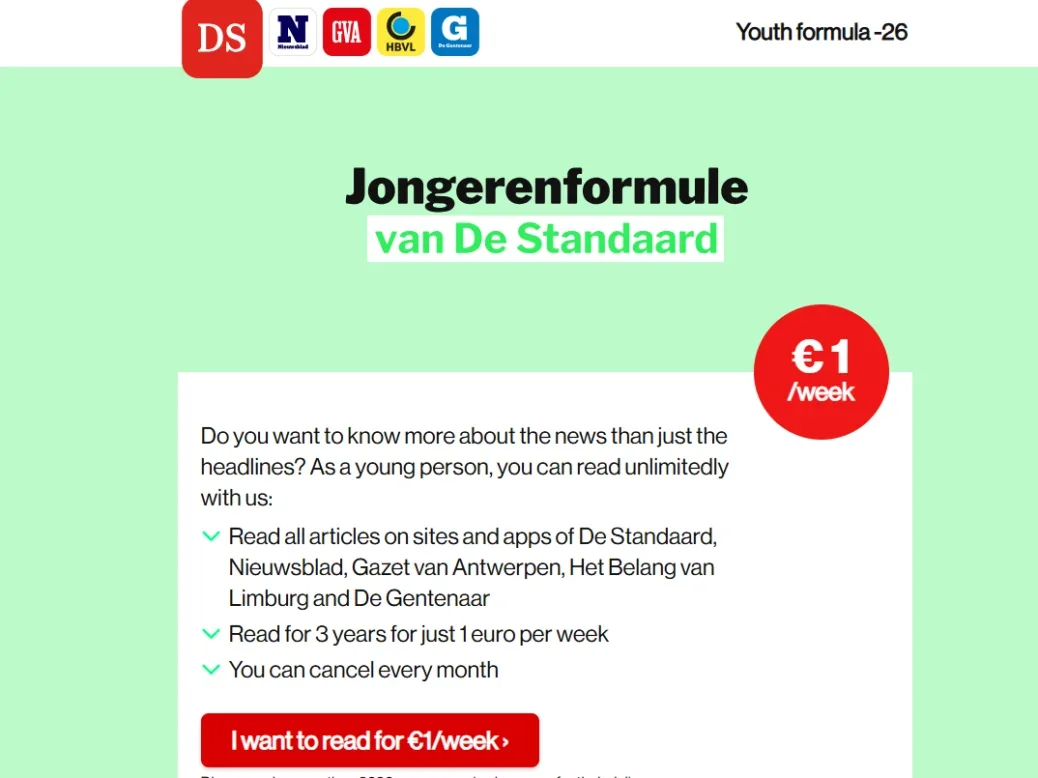
Mediahuis Belgium has proved that 18-25 year-olds will pay for news, but the publisher admits it is “hard work”.
A subscription costing €1 (85p) per week for those aged under 26 for a fixed term of three years launched in 2023 and currently has about 3,200 people signed up.
The publisher of national newsbrands De Standaard and Het Nieuwsblad as well as several regional titles has 432,000 subscriptions in total.
It sells subscriptions to 12% of households in the Flemish region of Belgium, “so to grow that is quite a challenge” – manager of acquisition and conversions for the title Katia Debusschere told The Audiencers Festival in London.
Until 2023 Mediahuis Belgium had a student subscription which gave a 20% discount compared to the normal price of either a full print and digital or Saturday print and digital package. But it was difficult to grow this, with the publisher discovering many were likely just using their parents’ accounts.
They decided they needed to grow digital subscriptions, which is a goal across the wider Mediahuis business. Mediahuis Ireland just crossed the 100,000 digital subscriptions mark at the Irish Independent and Belfast Telegraph while overall the company is aiming to reach 70% of revenue coming from digital by 2030.
Some 16% of people in Belgium pay for online news (14% French speaking and 17% Flemish) according to the latest Reuters Institute Digital News Report, just below the average of 18% across a basket of 20 richer countries.
In the US, where the figures were broken down into detail, just 18% of 18 to 24-year-olds said online news sites/apps were their main source of news compared to 54% relying on social media and video networks.
The average age of a Mediahuis Belgium subscriber is 64.5. “That is a huge challenge,” Debusschere said.
Mediahuis carried out qualitative research to find out what young people would pay for. The main takeaways, Debusschere said, were that they wanted a bundle of all titles in the group, the reading experience should fit their habits – meaning snackable, fast and including video – and that it must be clear what the added value is compared to being a free user.
Debusschere said: “If a subscription comes at a price you have to tell them this is what you get for the extra price.
“Young people expect more than a stream of newspaper articles. They want you to be their guide and to give them news in a very exciting, snackable way.” The newsroom has also been urged to create more snackable and video content to help draw young people in.
‘This is a thing of hard work’
The student offering made up 2% of total subscriptions and the goal was for the new youth pricing to match that within three years (which would mean reaching about 8,640).
Debusschere said they are about halfway towards this goal.
The latest Mediahuis annual report said the company ended 2024 with around 3,000 youth subscribers and the aim is to reach 5,000 by the end of this year.
The sign-up page for the youth subscription currently says: “Discover why more than 3237 young people choose us for their daily news.” The subscription makes clear people can choose to cancel any month, and people can benefit from the full three years even if they turn 26 during the term.
Debusschere said: “We are not completely there yet. It’s a long way. It’s not about a success story. This is a thing of hard work.”
She added that in terms of retention and churn the youth subscriptions are also not yet performing as well as the main subscription packages.
Debusschere said the challenges include the fact that they are targeting a small group, which also makes the marketing more expensive.
“This started as an experiment and something that we wanted to do, we want to be relevant for those young people,” she said.
“But this is not something you launch and then it stops. It will be a continuous process of optimising and being always alert on this project, and keep it in mind, and also provide enough budgets.”
The Mediahuis report said the areas of investment to boost youth subscriptions during 2025 were “job fairs, final-year high school students, video marketing and content creators”.
‘The same price as the foam on your beer’
Two marketing campaigns have been run so far: the first focusing on the €1 price point emphasising that it offers “reliable news for little money” and comparing it to cheap things that a young person could relate to such as the foam on their beer.
They had decided not want to offer it for free just to get young people through the door. Debusschere said: “Young people, they are willing to pay, because they do pay if they want something. They pay if they want to have a subscription on Netflix or Spotify, or if they want to subscribe on a Youtube person that they like, they do pay.”
The second campaign was to “unblock the full story”, leaning into people getting fed up with only getting the headlines from the increasing number of paywalled websites.
They also worked with influencers to raise awareness of the subscription, with Debusschere describing them as “very expensive but eager to work with us”.
The two three channels for acquisition have been Youtube Shorts, Snapchat and Tiktok.
Describing other channels that were tried out but failed, Debusschere said: “We did some email campaigns but young people don’t read their emails so we stopped that… Also they are not on Linkedin, that doesn’t work.
“And… Google Ad Manager, that is something we use on our own platform to show them banners but young people are not on our platforms so that didn’t work.”
Email pged@pressgazette.co.uk to point out mistakes, provide story tips or send in a letter for publication on our "Letters Page" blog
